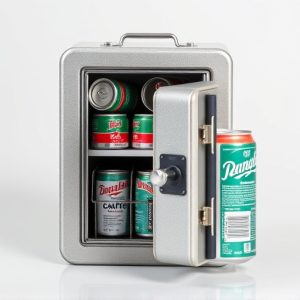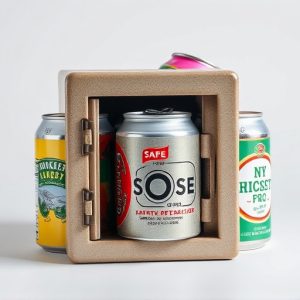Mastering Hidden Wall Compartments: Securing Your Space with Creative Paint Decoys
Hidden wall compartments behind paintings provide a discrete, secure storage solution for valuable i…….
Hidden wall compartments behind paintings provide a discrete, secure storage solution for valuable items and sensitive documents, enhancing interior decor while offering an innovative security tactic. By strategically placing decoy cleaning supplies, these hidden compartments protect against theft, making them a standout game-changer in security measures. Ideal for securing personal safety kits, heirlooms, or cash, seamless integration ensures they blend unobtrusively with home or office decor.
Uncover the art of concealed security with hidden wall compartments behind paintings—a clever solution for discrete storage. This article explores the multifaceted role of fake cleaning supplies as decoys in enhancing security and reveals creative ways to utilize these hidden compartments. Learn how to transform your paint job into a secure sanctuary, offering a unique and subtle method to protect valuable items. Discover the steps to create and fortify your own hidden wall compartment, mastering the ancient craft of secret storage.
- Understanding Hidden Wall Compartments: A Secret Storage Solution
- The Role of Fake Cleaning Supplies as Decoy in Security
- Creative Uses for Hidden Compartments Behind Paint
- How to Create and Secure Your Own Hidden Wall Compartment
Understanding Hidden Wall Compartments: A Secret Storage Solution
Many people don’t realize that their walls can serve as a clever and hidden storage solution. By integrating secret compartments behind paintings, you create a discrete space to store valuable items or sensitive documents. This age-old technique offers an elegant way to keep possessions secure while maintaining an unassuming exterior.
Hidden wall compartments behind paintings allow for versatile storage options. From housing important papers to concealing small treasures, these discreet spaces provide a level of privacy and protection. By carefully selecting the right painting and utilizing specialized construction techniques, you can create a functional art piece that serves as both decoration and a secure depository.
The Role of Fake Cleaning Supplies as Decoy in Security
In the realm of security, creative tactics are often employed to safeguard sensitive spaces. One such innovative approach involves the strategic placement of fake cleaning supplies as decoys, serving as a clever distraction from hidden wall compartments behind paintings. These faux supplies can be meticulously crafted and positioned to mislead intruders or thieves who might attempt unauthorized access. By drawing attention away from the actual safe haven, they play a pivotal role in enhancing overall security measures.
Imagine a scene where a would-be intruder, unaware of the sophisticated defenses, focuses their efforts on pilfering cleaning products. Meanwhile, behind a seemingly ordinary painting, a hidden wall compartment remains untouched, safeguarding valuable items or sensitive information. This tactic not only adds an extra layer of protection but also serves as a clever way to misdirect and deter potential criminals, making it a game-changer in the field of security.
Creative Uses for Hidden Compartments Behind Paint
Hidden wall compartments behind paintings offer a creative and stealthy solution for securing valuable items or sensitive materials. These concealed spaces can be ingeniously utilized to store a variety of objects, from important documents and small electronics to emergency supplies or even cash. By integrating these hidden compartments into your home or office decor, you create a secure storage system that blends seamlessly with your surroundings.
One innovative use could be for discretely housing a personal safety kit, including a first aid kit, flashlights, or even pepper spray, ensuring easy access in an emergency. Alternatively, they can serve as secret stashing spots for precious heirlooms, jewelry, or collectibles, providing peace of mind and protection against theft. The versatility of these hidden wall compartments makes them an attractive option for those seeking discreet, secure storage options within their living or working spaces.
How to Create and Secure Your Own Hidden Wall Compartment
Creating a hidden wall compartment behind painting is an ingenious way to conceal valuable items or sensitive documents. Start by selecting a suitable location, ensuring it’s within a solid wall and away from direct sunlight to prevent fading. This could be behind a larger piece of art or a mirror, where the space between the frame and the wall provides adequate depth for your compartment. Drilling into the wall at the desired height and width creates an opening large enough to accommodate your hiding spot. You can use a variety of tools for this task, depending on your comfort level and skill set. Once the opening is prepared, attach a hinge or a sliding mechanism to create a secret door that blends seamlessly with the surrounding wall. Consider using a thin, yet sturdy material like plywood or MDF to construct the compartment interior, ensuring it’s strong enough to support the weight of your hidden treasures.
Security is paramount when creating such a hiding place. Use heavy-duty locks or magnetic catches to secure the door and prevent unauthorized access. You might also consider incorporating an alarm system or motion sensors for added protection. The key to a successful hidden wall compartment is seamless integration, so ensure that the door closes flush with the wall surface, and any hardware is disguised or cleverly placed to avoid detection.
Hidden wall compartments behind paintings offer a sophisticated way to enhance home security, providing a safe haven for valuable items. By utilizing fake cleaning supplies as decoys, you can effectively mislead intruders, making it an innovative and discreet solution. With the right techniques, anyone can create these hidden spaces, ensuring peace of mind and adding an extra layer of protection to their belongings. Remember, when it comes to securing your space, thinking outside the box—or in this case, behind the paint—can make all the difference.


